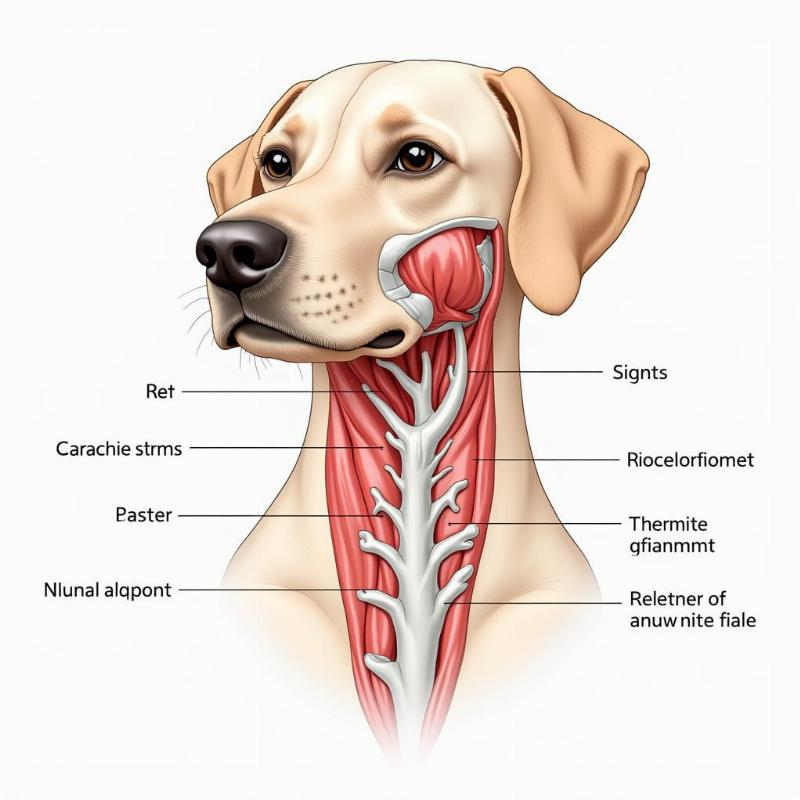Buffalo neck ligament in dogs, also known as the nuchal ligament, plays a vital role in supporting their heavy heads. This strong, elastic band of tissue connects the base of the skull to the spinous processes of the thoracic vertebrae, allowing dogs to hold their heads up with minimal muscular effort. Understanding its function and potential issues can help owners better care for their canine companions.
The Importance of the Nuchal Ligament in Canine Anatomy
The nuchal ligament’s primary function is to support the weight of a dog’s head. Imagine how tiring it would be to hold up something heavy all day! This ligament acts like a natural suspension system, reducing the strain on the neck muscles and allowing for efficient movement. This is especially important for breeds with large or heavy heads, such as bulldogs, mastiffs, and bloodhounds. Without a healthy nuchal ligament, these dogs would struggle to hold their heads up, leading to discomfort and potential injury.
 Dog Anatomy: The Nuchal Ligament
Dog Anatomy: The Nuchal Ligament
The nuchal ligament also contributes to a dog’s agility and balance. It helps stabilize the head and neck during running, jumping, and other activities, allowing for quick changes in direction and maintaining posture. This is crucial for working dogs, sporting breeds, and even everyday play.
Common Issues Affecting the Buffalo Neck Ligament in Dogs
While the nuchal ligament is remarkably strong, it can still be susceptible to injury or disease. Trauma, such as whiplash from a sudden jerk or impact, can cause sprains or tears. Overexertion, especially in active dogs, can also lead to inflammation and pain. In rarer cases, infections or tumors can affect the ligament.
Symptoms of nuchal ligament problems can vary depending on the severity of the issue. Some dogs may exhibit stiffness in the neck, reluctance to move their head, or pain when touched. Others might show more subtle signs like changes in posture, decreased activity levels, or difficulty eating or drinking.
Diagnosis and Treatment Options for Nuchal Ligament Issues
If you suspect your dog has a problem with their nuchal ligament, it’s crucial to seek veterinary care. A veterinarian will perform a physical examination and may recommend additional diagnostic tests, such as X-rays or ultrasound, to assess the extent of the injury or disease.
Treatment options depend on the specific condition. Mild sprains or strains may be treated with rest, anti-inflammatory medications, and physical therapy. More severe cases might require surgery to repair or reconstruct the ligament.
Preventing Nuchal Ligament Problems in Your Canine Companion
While not all nuchal ligament injuries are preventable, there are steps you can take to minimize the risk. Maintaining a healthy weight for your dog reduces stress on the ligament. Using a harness instead of a collar, especially during walks or runs, can prevent strain on the neck. Avoid sudden jerks on the leash and discourage activities that could lead to whiplash.
“Regular check-ups with your veterinarian are crucial for early detection of any potential issues,” advises Dr. Emily Carter, DVM, a leading veterinary orthopedist. “Early intervention can significantly improve outcomes and prevent long-term complications.”
Conclusion
The buffalo neck ligament, or nuchal ligament, is an essential part of a dog’s anatomy, providing crucial support and stability for their heads. Understanding its function and potential problems can help owners provide the best possible care for their furry friends. By being aware of the symptoms of nuchal ligament issues and taking preventative measures, you can contribute to a healthier and happier life for your canine companion. Remember, regular veterinary check-ups are key to early detection and effective treatment.
FAQ
- What is the buffalo neck ligament in dogs? The buffalo neck ligament, also known as the nuchal ligament, is a strong band of tissue that supports a dog’s head.
- What are the signs of a nuchal ligament injury? Signs include stiffness, pain, reluctance to move the head, and changes in posture.
- How is a nuchal ligament injury diagnosed? A veterinarian will perform a physical exam and may recommend X-rays or ultrasound.
- How are nuchal ligament injuries treated? Treatment can range from rest and medication to surgery, depending on the severity.
- Can nuchal ligament injuries be prevented? Maintaining a healthy weight, using a harness, and avoiding sudden jerks on the leash can help.
- Why is the nuchal ligament important? It supports the head, reducing strain on neck muscles and aiding in agility and balance.
- What breeds are more prone to nuchal ligament issues? Breeds with large or heavy heads, like bulldogs and mastiffs, are more susceptible.
Beautdogs.us is your premier source for comprehensive dog care information, breed-specific advice, and product reviews. We cater to both novice and experienced dog owners, offering authoritative guidance and valuable resources. As experts in canine health and wellness, we strive to empower you with the knowledge you need to give your furry friend the best life possible. Learn more about how we can help you and your beloved companion at Beautdogs.us. Contact us at [email protected] or call us at +1 501-555-7529.